A transcontinental research effort led by scientists from Vanderbilt University Medical Center and the University of Michigan has upended some long-standing assumptions about mutations — how often they occur, what causes them and what they do.
The team’s findings, published recently in the journal Science Advances, are helping to reveal why some people respond to cancer immunotherapy, for example, while others do not. The paper also illustrates why it is important to study large numbers of people of all ages and ancestral backgrounds.

“As we get older, we acquire more of these mutations,” said VUMC’s Alexander Bick, MD, PhD, the paper’s co-corresponding author with Joshua Weinstock, PhD, a postdoctoral scholar working jointly at Johns Hopkins and Stanford universities. “This may be a new contributor to disease.”
Bick, assistant professor in the Division of Genetic Medicine at VUMC, is well known for his studies of somatic (non-inherited) mutations in blood stem cells that can trigger explosive clonal growth (hematopoiesis) of abnormal cells.
This phenomenon, called clonal hematopoiesis of indeterminate potential or CHIP, can increase the risk for blood cancer and cardiovascular disease.
CHIP mutations occur in the coding regions of the genome, the parts of the DNA that encode enzymes and other proteins. What Bick, Weinstock and their colleagues discovered was that somatic mutations also occur frequently in the non-coding, non-protein-generating regions.
“People used to think that acquiring mutations was uncommon,” Bick said, “that it was unusual to get a mutation in your stem cells that causes disease … (and that) even when you did get a mutation in your stem cell, it was random.
“But no one had actually looked at this before,” he continued. “Certainly no one had looked in a large set of samples.”
The researchers, from more than 40 institutions across the country, examined blood cell genomes from more than 47,000 individuals in the Trans-Omics for Precision Medicine (TOPMed) program sponsored by the National Heart, Lung and Blood Institute, part of the National Institutes of Health.
“Sometimes you can see patterns when you have 50,000 genomes that you can’t see when you just have 2,000,” Bick explained.
“What we found was really quite surprising,” Bick said. “Acquired mutations that you weren’t born with are actually very common,” and seem to accumulate with age. “Pretty much everybody has at least one,” he said. “Most people in their 50s have 20 or 30 of them.”
The mutations differed among people of different ancestral backgrounds and weren’t random at all. “They were happening at very specific places, over and over again, across all these different people,” Bick said.
“We found a striking number of somatic mutations that were unexpectedly common in parts of the genome that are frequently ignored in cancer studies.” Weinstock said. “We found that these mutations are relevant to blood cell traits and are strongly associated with some inherited genetic variants.”
Arising in germ cells (egg and sperm), inherited mutations become part of the DNA in every cell of the progeny’s body and are passed down, from one generation to the next.
Bick compared inherited mutations to soil, and acquired mutations to seeds that grow out of that soil in a particular way. That would explain why somatic mutations occur in the same place, over and over again.
Through various means, and without changing the DNA, mutations in non-coding regions can regulate which genes are turned on, and which are turned off.
Eight of the mutations were found to have strong effects on blood cell traits, including the number of monocytes, a type of immune cell that plays a role in inflammation.
In addition to its potential relevance to inflammatory and auto-immune disease, this discovery may be particularly important in cancer, because cancer cells also acquire non-coding mutations that differ, depending upon whether a person is from New York or Khartoum or Shanghai.
“This finding, that these acquired mutations happen differently in people of different ancestries, opens up a new lens to try to understand why these very important cancer-fighting drugs might have different effects in different people,” Bick said.
In addition, Weinstock said, the current study represents “a broader line of work in human genetics that extends genetic epidemiology to acquired genetic variation in people without cancer.”
Others from VUMC who contributed to the paper were Benjamin Shoemaker, MD, MSCI, assistant professor of Medicine, and Dan Roden, MD, holder of the Sam L. Clark, MD, PhD Chair, and Senior Vice President for Personalized Medicine.
The study was supported by a Burroughs Wellcome Foundation Career Award for Medical Scientists, an NHLBI BioData Catalyst Fellowship, and NIH grants HL117626, HL120393, and OD029586. This content is solely the responsibility of the authors and does not necessarily represent the official views of the NIH.












